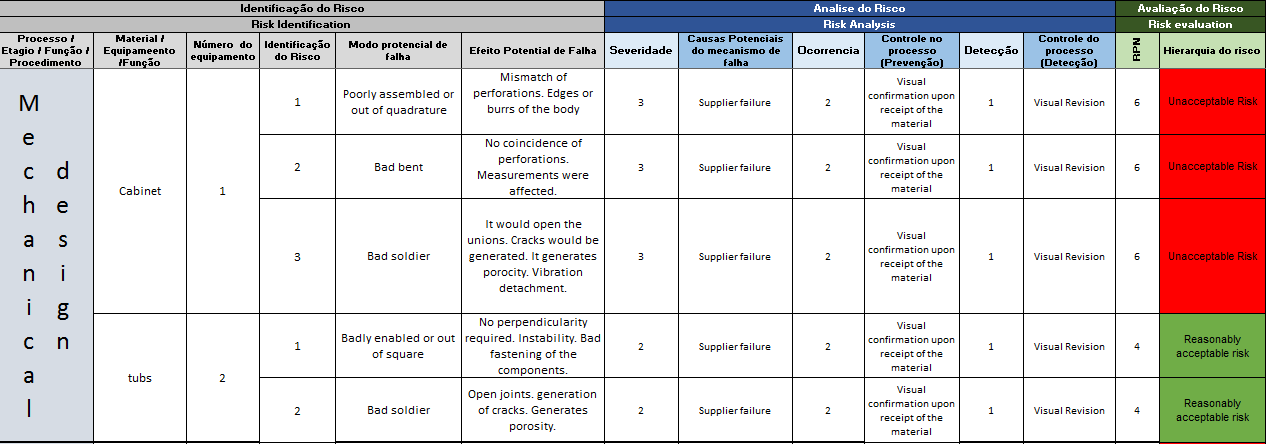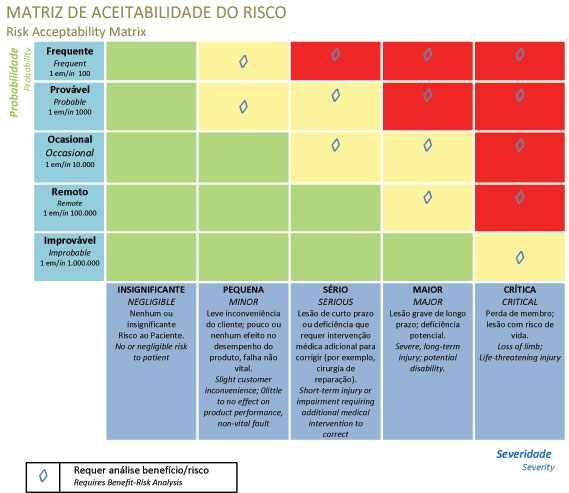The FMEA analysis aims to identify potential failure modes of a product or process in order to assess the risk associated with these failure modes so that they are classified in terms of importance and then receive corrective actions in order to reduce the incidence of failures . It is an important method that can be used in different areas of an organization such as: product design, process analysis, industrial and / or administrative area.
There are several types of FMEAS used worldwide. Among them, some can be used more than others, differing in some aspects as a way to classify the risks and names given to the elements. The way to apply the FMEA should be described in the company's risk management process. There is a possibility to carry out a single FMEA for the product, however there must be in the risk management process, product, process and post-market risk assessment.
Here is a description of some FMEAs:
Product FMEA: It analyzes failures that may occur in the product specifications focusing on components and subsystems. This type can also be called project female.
Process FMEA:It aims to analyze failures in the planning and execution of the process and consequently improve it.
System FMEA: Focuses on global systems functions
Service FMEA: Focuses on manufacturing and assembly processes
FMEA Software: Focuses on software functions.
FMEA is part of not all risk management, it is also part of this process the risk management plan and file. There will be situations in which another tool for risk assessment should be used and the documents cited will present all the methods used during the product's life cycle.
FMEA meeting
An FMEA meeting depending on the size of the project or process can take anywhere from half a day to several days, to identify all stages of the process or project.
In order to have a better result, a multidisciplinary team with people who participated in the project, process, commercial area and customer relationship must participate in the FMEA meeting, in addition to a product specialist. The greater the variety of people present, the more views of the product which results in a more comprehensive assessment.
The first focus of an initial FMEA should be:
- description
- Failure modes
- Failure Causes
- Current Process Control
DO NOT ATTEMPT TO DEFINE NUMBERS (Severity, Occurrence, Detection and RISK).
Once the failure modes have been exhausted, return to the numbers to assign severity, occurrence and detection. The RPN number from which the actions will be taken must be informed in the Product Risk Management File. After the conclusion of the FMEA, the residual risk ( RPN2) must be approved by the Project Manager. This approval must be registered in the Risk Management File.
FMEA meeting tips
The FMEA meeting is not for BRAINSTORMING.
Several FMEA meetings must be held throughout the project and development, some problems will arise and will require staff from outside the meeting, or data not available at the meeting, noted and resolved at the next meeting.
From personal experience in the first meetings, take as many known flaws as possible without evaluating them. Use FMEA of similar products so that it does not start from scratch.
Always have one person to coordinate / mediate the meeting and another person to report the meeting
The meeting facilitator should schedule a short break every hour.

FMEA document
The FMEA document consists of a list of components, functions or services that may fail. For each of these items, the occurrence, effects and failure modes are determined so that the risk inherent to the failure can be calculated. The risk value (RPN) is a multiple of 3 variables (Occurrence, Severity and Detection) .
Consider the definitions below:
- Failure: Loss of function when it is needed.
- Failure Mode: How do you observe the damage done.
- Failure effect: Result or consequence of the failure.
- Failure occurrence: How often does this happen.
- Failure severity: How severe is the failure when it occurs?
- Fault detection: Can I find the fault before it occurs?
- RPN: Risk priority number - It is the calculated risk that is associated with the failure mode.
The header of our FMEA must contain all important information such as the area where the component is located, the system to which it belongs, the start date, revision, team, developer, etc.

The fields of an FMEA are:
- Name: Name of the component, subcomponent or system being analyzed;
- Function: it is the function that the component or system performs;
- Failure: it is the event that causes the component or system to lose its function;
- Effects: Result of the failure occurrence;
- Severity: Severity is an assessment of the severity of the effect of the potential failure mode. Gravity applies only to the effect and follows the risk matrix.
- Cause: Presentation of the possible causes for the failure to occur;
- Occurrence: It is the probability that a specific mechanism or cause will occur. The only way to effectively reduce the occurrence rate is to remove or control one or more failure mechanisms through a design change.
- Detection: It is the possibility of detecting a failure in the project or in the process control mechanisms.
- Current actions and procedures;
- Recommended Actions;
- Responsibility;
- Expected date;
- Action taken;

When to conduct an FMEA?
The FMEA must monitor the product's life cycle, so it must be carried out:
- When designing the Product: Once the intended use of the product is defined
- In defining the product's production process including transfer
- Periodically, after released for commercialization. Production and customer data should be analyzed and used as input to the FMEA




